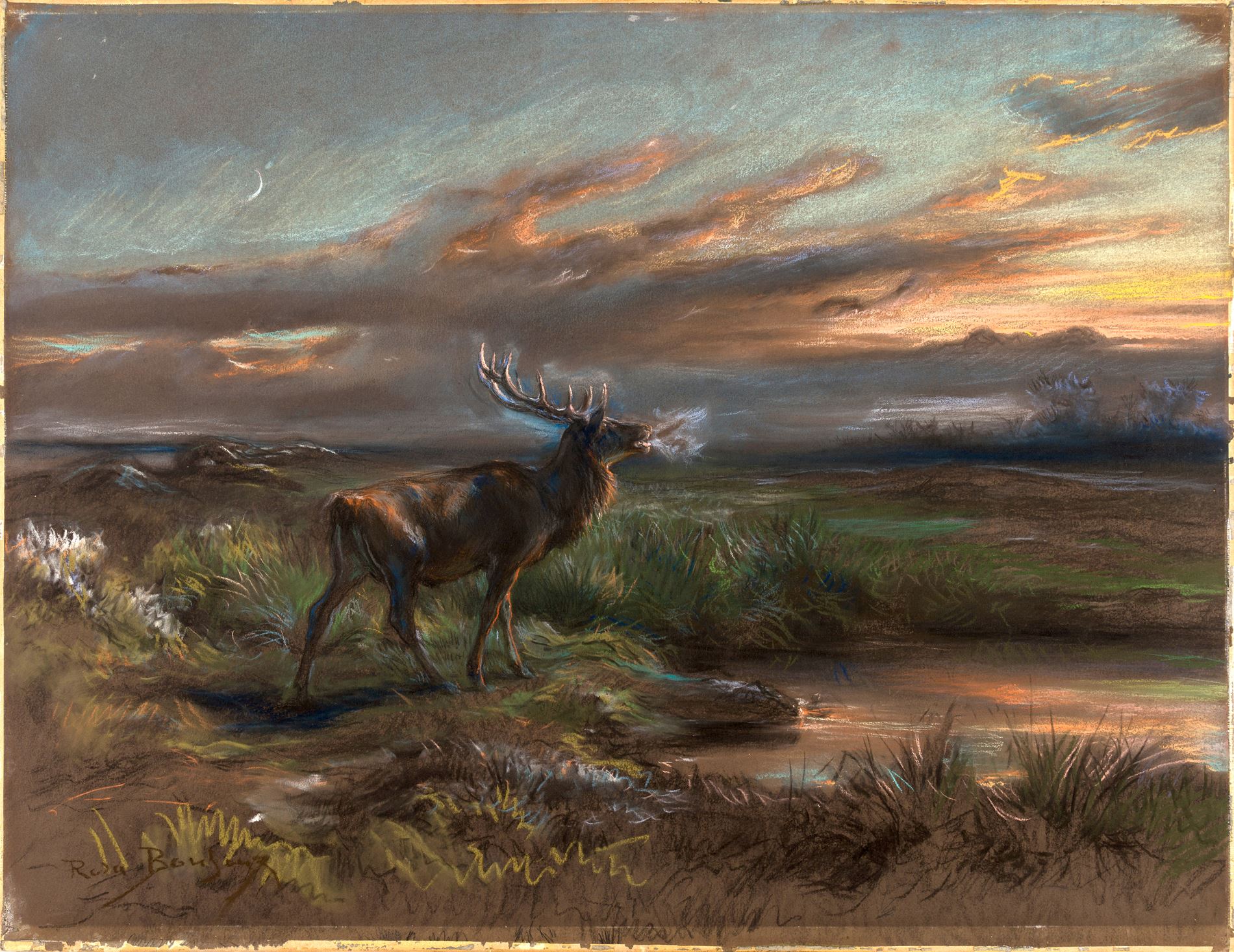Rosa BONHEUR
(Bordeaux 1822 - Thomery 1899)
The Call of the Stag
Sold
Pastel on brown paper, laid down on board.
Signed Rosa Bonheur at the lower left.
490 x 638 mm. (19 1/4 x 25 1/8 in.)
Signed Rosa Bonheur at the lower left.
490 x 638 mm. (19 1/4 x 25 1/8 in.)
This large pastel is datable to the decade of the 1890s, when Rosa Bonheur turned more towards the medium of pastel in order to achieve intense, luminous effects in her landscapes. The setting is the edge of the forest of Fontainebleau, which was once home to numerous stags, roes and roebucks, as well as wild boar, rabbits and pheasants. (A very similar landscape setting at Fontainebleau is seen in a large lithograph by Bonheur, signed and dated 1865, depicting a stag and several deer in identical terrain.) As an early account of the artist noted, ‘Another change in the Fontainebleau forest also caused deep regret in the heart of Rosa Bonheur. I refer to the drying up of the ponds, which seems to be in course all over the region. She thought this waning symbolised the gradual decline of her own life. This disappearance of the water in the neighbourhood of the Gorge aux Loups removed still another attraction from that spot. In those earlier days, the Mare aux Fées, now scarcely more than a marshy hollow, contained shallow but limpid water, while its banks and the plateau roundabout were covered by a short, thick turf, in the midst of which rose up those healthy isolated oaks. At night the moon would light up the whole scene most beautifully, and then it was that Rosa Bonheur, hidden behind a tree or shrub, would lie for hours together, watching the stags who would come there from miles around in order to quench their thirst, and who, in the autumn, when in heat, would lock antlers and fight sturdily on the banks. Many were the studies of combating stags that Rosa Bonheur bore away in her mind from the Mare aux Fées, and transferred to canvas early next morning in her studio.’
Among thematically and stylistically comparable works by Rosa Bonheur is a very large pastel on canvas of A Stag and Three Doe in a Misty Mountainous Landscape, signed and dated 1897, which appeared at auction in 1985, and The King of the Forest, also dated 1897, which was sold at auction in 2007. Two similarly sizeable pastels of A Stag in the Mist and Stag and Deer, Morning Effect were both exhibited at the Galerie Georges Petit in Paris in 1897; the latter work reappeared at auction in New York in 2001.
The present sheet belonged to the Swiss lawyer and politician Adolf Streuli (1868-1953).
Annie-Paule Quinsac has confirmed the attribution of this pastel to Rosa Bonheur.
Among thematically and stylistically comparable works by Rosa Bonheur is a very large pastel on canvas of A Stag and Three Doe in a Misty Mountainous Landscape, signed and dated 1897, which appeared at auction in 1985, and The King of the Forest, also dated 1897, which was sold at auction in 2007. Two similarly sizeable pastels of A Stag in the Mist and Stag and Deer, Morning Effect were both exhibited at the Galerie Georges Petit in Paris in 1897; the latter work reappeared at auction in New York in 2001.
The present sheet belonged to the Swiss lawyer and politician Adolf Streuli (1868-1953).
Annie-Paule Quinsac has confirmed the attribution of this pastel to Rosa Bonheur.
Marie-Rosalie (always known as Rosa) Bonheur was the eldest child of the minor painter Raymond Bonheur, with whom she received her initial training. (Her three younger siblings, Auguste, Juliette and Isidore, were also to become artists.) Developing a particular penchant for animals, landscapes and pastoral subjects, she exhibited for the first time at the Salon of 1841, eventually winning a third-class medal in 1845 and a gold medal four years later. A commission from the State resulted in a large painting of Oxen Ploughing in the Nivernais, exhibited to considerable acclaim in 1849 and today in the Musée d’Orsay. In 1851 she began work on another huge canvas, The Horse Fair, which was completed in 1853 and exhibited at the Salon that year. The painting was eventually purchased for 40,000 francs by the Victorian art dealer and entrepreneur Ernest Gambart, and initiated a long and successful commercial relationship with the artist. At the Salon of 1855 a painting of Haymaking in the Auvergne, commissioned by the Duc de Morny, was awarded another gold medal. This was to be Bonheur’s last contribution to the Salons for several years, however.
In 1856, at the instigation of Gambart, she visited England and Scotland, meeting Queen Victoria and several prominent figures in the English art world, including Edwin Landseer – her British counterpart as an animal painter, and equally successful - and John Ruskin. In the succeeding years she began to retreat from the Paris art world, eventually establishing her home and studio in the Château de By in Thomery, at the edge of the forest of Fontainebleau. She continued to receive numerous honours including, in 1865, membership in the Légion d’Honneur; the first woman artist to be admitted. She again exhibited her work in Paris, after an absence of more than a decade, at the Salon of the Exposition Universelle in 1867. One of the most famous and honoured artists of the day, Rosa Bonheur continued to work with much success, enjoying a lucrative market for her animal paintings in France, England and America, until her death at the Château de By in 1899.
Provenance
Arthur Tooth and Sons Ltd., London
Acquired from them in April 1932 by Adolf Streuli, Zurich
Thence by descent until 2018.
Acquired from them in April 1932 by Adolf Streuli, Zurich
Thence by descent until 2018.





